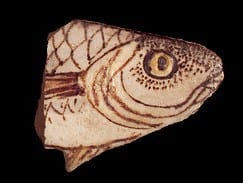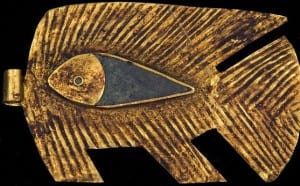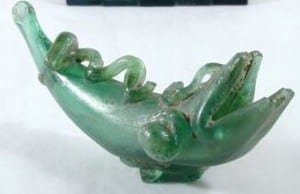Petrie Menagerie: The Aquarium and Reptile House
By Edmund Connolly, on 30 August 2013
Our animal companionship has grown, with horses meandering along Egyptian groves, alongside languid hippos and regal lions. Returning to our first specimen, the hippo, we will dive once more into the waters to cavort in an aquarium of fish and chill in the boreal shades of a reptile house.
Petrie Menagerie #5: The Aquarium and the Reptile House
Egypt has two major water sources: the Nile which acts as a spine for the country, running down into Africa, and the Mediterranean sea. Both were essential for the trade routes, travel and artefacts that Ancient Egyptians are so famous for. In addition, these important bodies of water held swarms of fish, which were a key element of the Ancient Egyptian diet. Reptiles appear in Egyptian iconography principally as snakes, scorpions and crocodiles[1] in a host of iconographic, religious and spiritual incarnations.
The Object:
Unsurprisingly fish are a frequent representation, in simple and more complex forms:
Excavated at the site of Armana this would have been a furniture inlay, perhaps for a couch or chair, no doubt of a wealthy individual, clearly with a penchant for marine animals. This chap is made from faience, a type of glazed ceramic which uses similar components to glass making to render a myriad of vibrant tones and colours. This fish could be some sort of mackerel, with its slim body, and the Egyptians had a taste for fish, as described by Herodotus in Book II. Despite the supposed popularity of fish, they were apparently snubbed by priests and wealthier Egyptians for being unclean[2].
Aside from these more literal representations, fish are also presented in more abstract forms
This gold fish pendant is made of slim sheet gold with incised lines echoing the larger shape of a fish tail and fins, and a central fish-like body of blue paste encased in more gold. At the end is a loop for suspending the pendant, most probably to be worn as a necklace. This fish is another of my favourites from the collection, sadly not on display, but I love the deco styling and abstract interpretation of a fish. Indeed, it actually looks quite like an eye, a protective pendant; perhaps the artist was rendering a fish in a protective mantra? Also, when it would be suspended the fish would be swimming ‘upwards’, towards the head of the individual, perhaps there was more to fish representations than cuisine and zoology?
Snakes held a far more revered position for Ancient Egyptians, and appear as the Uraeus (an upright cobra which denotes sovereignty), Wadjet (a protective goddess) and in fun, novelty pottery:
Wadjet was an important goddess, who originally represented the protection of Lower Egypt and, when Upper and Lower unified, was adopted as a more all-encompassing protective deity. Her oracle at Per-Wadjet was considered a very important religious site and may have led to the rather obsessive trait of the Ancient Greeks for indulging in oracle prophecies (Herodotus II, 55 and VII 134).
Petrie’s Peers:
Snakes, scorpions and the like would certainly have been recognised by a contemporary audience, regardless of their exotic background. What is more questionable are the representations, such as the Uraeus, or the stylised pottery (above), would these be considered real serpents, represented in a stylised format, or do they signify a more fantastic creature?
The story of Cleopatra and her reptilian demise has cemented the representation of snakes and Ancient Egypt firmly together. Considering this rather drastic application of a snake, would this have made the Uraeus seem oppressive and predatory, even a harbinger of death?
I don’t think anyone sees death in a fish, unless you’re some sort of pond weed. In addition to the recognisable fish, the Petrie holds some exquisite dolphin pieces:
which would have proved more novel. Although London Zoo opened the doors to its ‘Fish House’ (later to becoming Aquarium) in 1853, no marine mammals were present in the displays.
The Menagerie:
The fish artefacts offer a valuable insight into the daily lives of Egyptians, much like any community with access to large bodies of water they no doubt ate and were inspired to represent the watery animals in art and artefact. With the snakes the first example of reinterpretation rears its many faced head. Infamous and famous events, like the death of Cleopatra and temptation of Eve would lead many a Victorian viewer of snakes to shun them, or presume evil. Although there appears little to no proof the Egyptians held such resentment, it is credible to presume that here our Victorians and Ancient Egyptians would clash heads.
Personally, I cannot stand snakes; I am terrified of the things! And, I have stroked tarantulas, had a vulture on my head and carried a crocodile, but if a small grass snake crosses my path I am out. I feel this just makes me more like Indiana Jones, so there is a silver lining to this irrationalism.
Next time we shall take to skies on the soaring wings of a bird-beetle…?
 Edmund works at the Petrie Museum of Egyptian Archaeology as the Projects Coordinator. He graduated from the Institute of Archaeology, UCL, in 2012 and plays sport for UCL almuni and ULU.
Edmund works at the Petrie Museum of Egyptian Archaeology as the Projects Coordinator. He graduated from the Institute of Archaeology, UCL, in 2012 and plays sport for UCL almuni and ULU.
[1] But they are quite good fun and deserve a post all of their own, perhaps the last in the series.
[2] Excellent table here uses bones finds to speculate the quality of fish meat and popularity in Ancient Egyptian cuisine: http://www.digitalegypt.ucl.ac.uk/foodproduction/fishearlyegypt.html
One Response to “Petrie Menagerie: The Aquarium and Reptile House”
- 1
 Close
Close








[…] London has over 80,000 objects and is the world’s leading collection of Egyptian material. What you can expect inside. Here’s […]